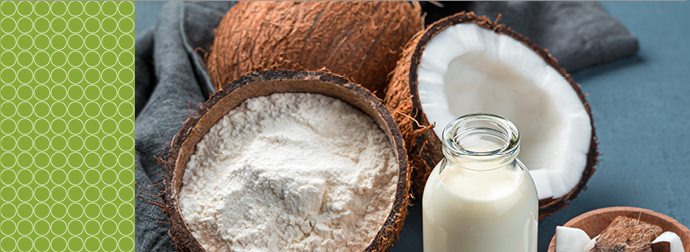
Recent news in Food & Feed Analysis
- Home
- /
- World Coconut Day –...
World Coconut Day – 8 surprising facts

International Coconut Day is celebrated on September 2nd. The coconut palm grows in the tropical belt, yet it is no longer considered exotic here; it has long been a staple of our cuisine. Here are 8 startling facts.
1. Is the coconut a nut?
Whoever gave the coconut its name was mistaken about the genus. The coconut is not a nut, but a drupe. It is also not round, but has a triangular shape.
2. Where does it come from?
Coconut palms may be found across the tropical belt. Their fruit, the coconut, can germinate for a long period, thus it might have migrated from island to island. However, it cannot be grown in these latitudes. The palm tree requires a minimum temperature of 20 degrees and a lot of rain. Due to the elasticity of the stem and the leaves, they can survive storms. Coconut palms yield fruit all year, thus they are not simply seasonal.
3. How healthy is the coconut?
Coconuts keep their freshness for a long time due to their light and water-resistant shell. However, this was not the only reason they were popular on ship journeys. Coconut is also high in nutrients such as vitamin C, minerals, lipids, and protein.
4. A hidden allergen?
Coconuts can induce allergic responses, however this is uncommon. As a result, the FDA added the fruit to its list of food allergens in 2006. Tests reveal whether or not food product lines include residues of coconut.
5. How versatile is the coconut?
The coconut is not just eaten in its native country. People value its shell as well. It is utilized in the production of daily things including as dinnerware, cutlery, and floor mats, as well as jewelry.
6. What is the difference between coconut milk, coconut water and coconut oil?
These words are frequently used interchangeably. The liquid found within the fruit is known as coconut water. Coconut fat (also known as coconut oil) is made from dried and pressed coconut flesh. Coconut milk, on the other hand, is made from a combination of coconut water and white pulp. It is also possible to make it yourself.
7. How do I drink from a coconut?
If you’re ever stuck on a desert island and don’t know how to break a coconut: it has a soft spot. When you look at the coconut, you will notice three dots (sprout holes) that form a face. The “forehead” is the weak part where you should begin to open the fruit. If a straw is available, it can also be punctured here.
8. Are there also green coconuts?
The classic brown coconut found in supermarkets, with its woody brown shell, is not the entire fruit. The shell is made up of an exterior skin that is green, yellow, or brown and is generally removed soon after harvest. The stone core is represented by the brown coconut.


